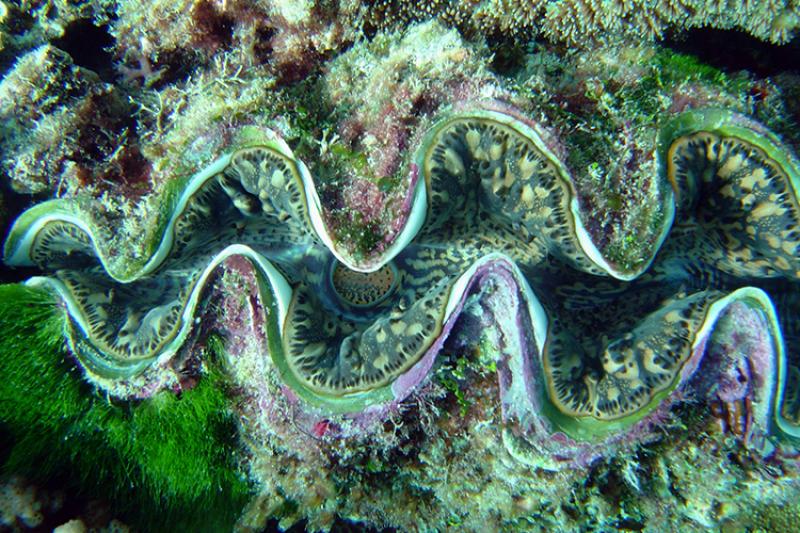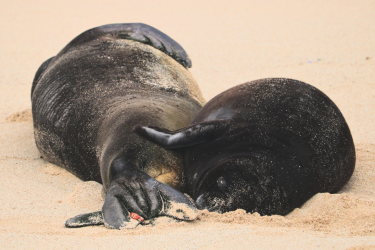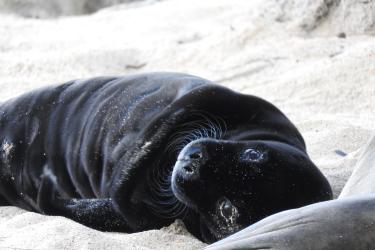NOAA Fisheries supports and promotes a range of offshore and inshore aquaculture projects across the continental United States and the Pacific Islands region. And when it comes to talking about aquaculture (farming seafood), the last thing we want to do is clam up.
But we’re helping a U.S. territory “clam up” in an entirely different sense. A NOAA funded project in Guam is setting up giant clam aquaculture in two southern villages, Inalåhan and Malesso. The project will improve the livelihoods of community members by providing food, jobs, and shells for cultural practices and artisanry. It’ll also train the next generation of giant clam aquaculture specialists through internships.
“It’s going to help Guam become a more food-independent, self-sustaining island,” said project lead Frank C. Roberto, a biologist at Guam’s Department of Agriculture, Division of Aquatic and Wildlife Resources (DAWR).
Giant clams, or hima in the CHamoru language of the Mariana Islands, are an important part of Guam’s culture. Archaeological findings show that the island’s people used clam shells for tools such as adzes, scrapers, and knives. They also incorporated the shells into body ornamentation and precious jewelry, including sinahi, a crescent moon necklace that’s a symbol of CHamoru pride and culture.
Today, hima are still harvested for meat and jewelry (often sold within the community and to tourists), but they’ve become a regulated species due to overharvesting.
Roberto hopes the project will simultaneously create a sustainable supply of domestic food and provide seed stocks to help restore reefs and wild clam populations. The aquaculture project is part of an island-wide effort to expand domestic food options. Currently, Guam imports more than 90 percent of food and has no major export crop.
Community Aquaculture
A 2021 pilot project, in collaboration with Inalåhan Mayor Anthony Chargualaf, planted giant clams collected from various Guamanian reefs into Inalåhan tide pools. The endeavor garnered overwhelming community support. It also led Malesso Mayor Ernest Chargualaf to request his village become a second cooperative extension site for giant clam aquaculture.
For the new project, the Aquaculture Association of Palau is supplying DAWR with 1,000 giant clams, some of which will serve as broodstock for future projects. DAWR will provide the villages with the necessary materials and knowledge for hima aquaculture, including equipment to construct the farm and in-water cages. The villages will be responsible for constructing and managing the farm.
“It’s better to have the community involved because it gives them a better respect for and connection to the project,” Roberto said.
Ten high-school interns will be recruited from the two villages to serve as “Hima Ambassadors.” They will receive mentoring and training in all aspects of the project, including educational workshops focused on inducing clams to spawn and rearing larvae.
The interns will also be involved in outreach efforts to increase community awareness of and involvement in the project. Planned outreach includes participating in a cultural clam-dish cook-off and working with local carvers to create beautiful indigenous body ornamentations from the shells.
Ultimately, the project will help revitalize CHamoru cultural ties to natural marine resources and may one day help rebuild Guam’s giant clam populations.
“We’re not trying to change the world with giant clam farming in Guam,” Roberto said. “We’re trying to increase our village communities’ capacity for this type of work, elevate the ancestral knowledge that’s already here, and support cultural, environmental, and economic security.”
The funds for this project are being administered by the Pacific States Marine Fisheries Commission.










